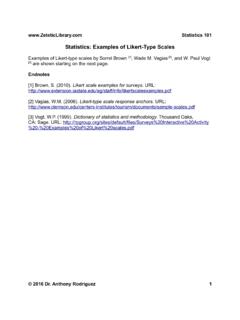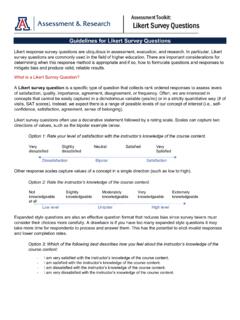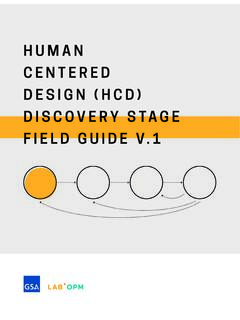Transcription of Test of e-Learning Related Attitudes (TeLRA) scale ...
1 International Journal of Education and Development using Information and Communication Technology (IJEDICT), 2016, Vol. 12, Issue 1, pp. 20-36 Test of e-Learning Related Attitudes (TeLRA) scale : Development, reliability and validity study D. H. Kisanga and G. Ireson Nottingham Trent University, United Kingdom ABSTRACT The Tanzanian education system is in transition from face-to-face classroom learning to e-Learning . e-Learning is a new learning approach in Tanzanian Higher Learning Institutions [HLIs] and with teachers being the key stakeholders of all formal education, investigating their attitude towards e-Learning is essential. So far, however, there has been little consideration given to research that examines teachers Attitudes towards e-Learning in Tanzanian HLIs and consequently, there is no standard attitude scale that has been developed to measure this.
2 This paper presents the development and validation of a scale of teachers attitude to e-Learning . Whilst being initially developed to assess the attitude of teachers in HLIs the authors belief, having piloted with pre-service trainee teachers in England that the scale transfers across national boundaries. The final instrument contains 36 items with a Cronbach alpha score of Although the developed attitude scale was intended for use in HLIs, it can also be of interest to researchers investigating Attitudes on other sectors. Keywords: Attitude, TeLRA scale , e-Learning . Abbreviations: HLIs Higher Learning Institutions; ICT Information and Communications Technology; TeLRA Test of e-Learning Related Attitudes .
3 INTRODUCTION e-Learning has, over recent years, become ever more popular and it is gaining wide acceptance as a non-traditional mode of accessing higher education (UNESCO, 2009). Researchers investigating the role of e-Learning in education systems suggested it to be the best alternative to cope up with constraints to access education (Garrison & Anderson, 2003; Weller, 2007; Clarke, 2008; Garrison, 2011). e-Learning improves efficiency, effectiveness, quality, time and access of education at all learning levels (COL 2003; Littlejohn and Pegler 2007; Salmon 2011). One aspect of success of e-Learning programs depends, to a considerable extent, on teachers Attitudes towards e-Learning systems (van Raaij & Schepers, 2008).
4 Teachers play a key role in the integration of e-Learning in education such that their Attitudes towards e-Learning have significant impact not only to students attitude formation toward e-Learning (Pynoo et al., 2012) but also on the education transformation agenda as a whole. However, a willingness to change from traditional learning approaches like face-to-face to e-Learning is a social phenomenon where attitude has an important role to play. The concept of attitude has been one of the most influential phenomena of all social and psychological constructs (Fishbein & Ajzen, 1980). Throughout the history of social psychology, social scientists have used attitude to explain human actions, since they regarded Attitudes as a behavioural disposition.
5 This study defines attitude to be positive or negative evaluative judgement of an entity based on affective, cognitive or behavioural experience (Schwarz, 2007). It implies that, people s evaluative judgment of an entity depends on how they feel about it (affective evaluation), knowledge they have about the object (cognitive evaluation) and how they Test of e-Learning Related Attitudes (TeLRA) scale 21 have acted towards it in the past (behavioral evaluation) (Eagly & Chaiken, 2007). Early literature on teachers attitude towards technology development, adoption and implementation define attitude toward technology as an affective or evaluative judgement about the technology in question (Davis, Bagozzi & Warshaw, 1989; Barki & Hartwick, 1994).
6 Technology which is believed to be both important and personally relevant is more likely to generate people s positive attitude towards it (Rogers, 2003). Examination of numerous approaches used to measure attitude reveals that attitude scales are the most commonly used with summated rating likert scales (Albaum, 1997; Johns, 2010). A likert , or likert -like, scale employs self-reporting methods with a series of questions focused on assessing Attitudes . Respondents would rate the attitudinal object by choosing the best option that reflects their level of agreement or disagreement ( likert , 1932). The response format in the likert scale has been adopted in various attitude scales amongst which is the Test of Science Related Attitudes , TOSRA (Fraser, 1981).
7 TOSRA is a five-point scale that requires respondents to express their degree of agreement to each statement as either strongly agree, agree, not sure, disagree or strongly disagree. The purpose of the work presented here was to develop and validate an attitude scale to assess teachers Attitudes towards e-Learning . Constructs of the TOSRA scale were modified to develop the Test of e-Learning Related Attitudes (TeLRA) scale . The TeLRA scale can be considered to be a reliable and valid measure of Attitudes towards e-Learning from a sample of teachers from Tanzanian HLIs. Justification for developing and using TeLRA scale as well as evidence for the reliability and validity of the scale are also discussed.
8 Conceptual framework This study reports part of the research conducted in Tanzanian HLIs that investigated teachers Attitudes towards e-Learning . The study was guided by Davis (1986) Technology Acceptance Model (TAM) (see Figure 1).
9 Figure 1: TAM Model Source: Davis et al., (1989). TAM is an information systems theory that predicts how the user comes to accept and use technology. The model consists of four constructs: external variables (EV), teachers perceived usefulness (U), teachers perceived ease of use (EoU) and the teachers attitude (A) toward e-Learning . Two constructs from TAM namely, behaviour intention and actual system use were not included in the conceptual framework because usage of e-Learning in Tanzanian HLIs is still in its infancy (Hooker et al.)
10 , 2011; Sanga et al., 2013), and therefore, attitude (A) was selected to be a dependent variable. In this model, EV was suggested to mediate the impact of the two constructs External Variables (EV) Attitude Toward Using (A) Perceived Ease of Use (EoU) Perceived Usefulness (U) Behaviour Intention to Use (BI) Actual System Use 22 IJEDICT U and EoU on A with single directional arrows representing one way impact. TAM is helpful for both prediction and explanation in the sense that through user s internal beliefs and different significant variables, the researcher can identify reasons that lead to adoption or rejection of e-Learning and find appropriate corrective measures or explanations for that decision (Davis et al.

















